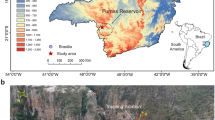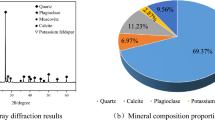Abstract
This paper proposes an analytical approach for assessing rock slope stability based on a three-dimensional (3D) Hoek–Brown (HB) criterion to consider the effects of intermediate principal stress. The 3D HB criterion, considering an associate flow rule, is utilized to describe the perfectly plastic behavior of rock mass under a plane strain condition. To reflect the change of friction angle on the failure surface, the potential failure surface (PFS) is divided into small segments with each segment being assigned a unique friction angle. The upper bound theorem of limit analysis is combined with the strength reduction method to determine the factor of safety (FOS) of a rock slope with a defined PFS. By optimizing the PFS, the minimum FOS and the critical failure surface (CFS) of the rock slope are obtained by the customized genetic algorithm. The proposed approach is validated by comparing it with an HB criterion-based solution and numerical simulations. Parametric studies are also performed to investigate the effects of rock mass properties, slope geometry, and loading conditions on the FOS and CFS. The results indicate that ignoring the 3D strength of rock leads to underestimation of FOS and it is important to consider the various factors when evaluating the stability of a rock slope. For the effortless application of the proposed approach, a Python-based graphical-user-interface application is developed as a stand-alone executable app and is successfully applied to analyze a rock slope.
Highlights
-
Three dimensional (3D) Hoek-Brown criterion is applied to analyze rock slope stability
-
Customized-genetic algorithm is utilized to accelerate finding most critical condition
-
Ignoring 3D strength of rock mass leads to underestimation of the factor of safety for a rock slope
-
Graphical-user-interface app was developed using Python for effortless application of the proposed approach



















Similar content being viewed by others
Data availability
The datasets generated during and/or analysed during the current study are available from the corresponding author on reasonable request.
Abbreviations
- \(\overrightarrow{{n}_{\mathrm{i}}}\) :
-
Normal unit vector on the failure surface
- \({\mathrm{FOS}}_{\mathrm{lb}}\), \({\mathrm{FOS}}_{\mathrm{ub}}\) :
-
Lower and upper bounds of FOS
- \({D}_{\mathrm{in}}\) :
-
Dissipation rate of internal plastic work
- \({D}_{\mathrm{in}.\mathrm{r}}\) :
-
Dissipation rate of the required stresses
- \({I}_{1}^{*}\), \({I}_{2}^{*}\), \({I}_{3}^{*}\) :
-
Modified first, second and third stress invariants
- \(\overrightarrow{T}\), \(\overrightarrow{X}\), \(\overrightarrow{v}\) :
-
Traction force vector on boundary; body force vector; velocity vector
- \({W}_{\mathrm{ex}}\) :
-
Work rate of external loads
- \({c}_{1}\), \({c}_{2}\), \({c}_{3}\) :
-
Constants defining the relation between \({\phi }_{\mathrm{tr}}\) and \(\theta\)
- \({c}_{\mathrm{t}}\) :
-
Instantaneous cohesion of rock mass
- \({f}_{\mathrm{NMGZZ}}\) :
-
Failure surface of the newly modified GZZ criterion
- \({k}_{\mathrm{v}}\), \({k}_{\mathrm{h}}\) :
-
Vertical and horizontal seismic coefficients
- \({m}_{\mathrm{b}}\) :
-
Constant parameter of rock mass
- \({m}_{\mathrm{i}}\) :
-
Constant parameter of intact rock
- \({n}_{\mathrm{pop}}\) :
-
Population of each generation in the genetic algorithm
- \({q}_{\mathrm{d}}\) :
-
Deviatoric shear stress
- \({r}_{\mathrm{a}}\) :
-
Radius of the failure surface on the top of the slope
- \({r}_{\mathrm{f}}\) :
-
Failure surface determined by \({\phi }_{\mathrm{t}}\)
- \({r}_{\mathrm{fr}}\) :
-
Failure surface determined by \({\phi }_{\mathrm{tr}}\)
- \({r}_{\mathrm{s}}\) :
-
Polar function of the slope surface
- \({x}_{\mathrm{c}}\), \({z}_{\mathrm{c}}\) :
-
Horizontal and vertical coordinates of the center of rotation
- \({x}_{\mathrm{t}}\) :
-
Horizontal distance from slope toe
- \({\gamma }_{\mathrm{rm}}\) :
-
Unit weight of rock mass
- \({\varepsilon }_{y0}\) :
-
Initial strain of rock mass in the out-of-plane direction
- \({\theta }_{\mathrm{a}}\), \({\theta }_{\mathrm{o}}\), \({\theta }_{\mathrm{b}}\) :
-
Polar coordinates of the failure surface at points A, O, B (top, corner, and toe)
- \({\mu }_{\mathrm{rm}}\) :
-
Poisson’s ratio of rock mass
- \({\phi }_{\mathrm{t}}\) :
-
Tangential friction angle of rock mass on the failure surface
- \({\sigma }_{1}\), \({\sigma }_{2}\), \({\sigma }_{3}\) :
-
Major, intermediate, and minor effective principal stresses
- \({\sigma }_{1}^{*}\), \({\sigma }_{2}^{*}\), \({\sigma }_{3}^{*}\) :
-
Modified major, intermediate, and minor effective principal stresses
- \({\sigma }_{\mathrm{c}}\) :
-
Unconfined compressive strength of intact rock
- \({\sigma }_{\mathrm{ij}}\) :
-
Stress tensor
- \({\sigma }_{\mathrm{ijr}}\) :
-
Required \({\sigma }_{\mathrm{ij}}\) for stability
- \({\sigma }_{\mathrm{n}}\), \(\tau\) :
-
Normal stress and shear stress
- \({\sigma }_{\mathrm{v},\mathrm{ b}}\) :
-
Vertical stress at the toe of the slope
- \({\sigma }_{x}\), \({\sigma }_{y}\), \({\sigma }_{z}\) :
-
Normal stresses in the horizontal, out-of-plane, and vertical directions
- \({\sigma }_{x0}\), \({\sigma }_{y0}\), \({\sigma }_{z0}\) :
-
Initial values of \({\sigma }_{x}\), \({\sigma }_{y}\) and \({\sigma }_{z}\)
- \({\tau }_{\mathrm{r}}\), \({c}_{\mathrm{tr}}\), \({\phi }_{\mathrm{tr}}\) :
-
Required values of \(\tau\), \({c}_{\mathrm{t}}\) and \({\phi }_{\mathrm{t}}\) for stability
- \(\mathrm{FOS}\) :
-
Factor of safety
- \(\mathrm{GSI}\) :
-
Geology strength index
- \(D\) :
-
Disturbance factor representing the effects of construction methods
- \(H\) :
-
Height of slope
- \(S\), \(V\), \(F\) :
-
Boundary surface, volume, and failure surface of kinematic failure mechanism
- \(a\) :
-
Constant parameter of intact rock and rock mass
- \(n\) :
-
Number of segments constituting the failure surface
- \(q\) :
-
Load on the top of the slope
- \(s\) :
-
Constant parameter of intact rock and rock mass
- \(\alpha\) :
-
Slope angle at the toe of the slope
- \(\beta\) :
-
Inclination of the top of the slope
- \(\theta\) :
-
Polar angle measured clockwise from the positive x-direction
References
Benz T, Schwab R, Kauther RA, Vermeer PA (2008) A Hoek-Brown criterion with intrinsic material strength factorization. Int J Rock Mech Min Sci 45(2):210–222. https://doi.org/10.1016/j.ijrmms.2007.05.003
Bishop AW (1955) The use of the slip circle in the stability analysis of slopes. Géotechnique 5:7–17. https://doi.org/10.1680/geot.1955.5.1.7
Carranza-Torres C (2004) Some comments on the application of the Hoek–Brown failure criterion for intact rock and rock masses to the solution of tunnel and slope problems. In: Barla G, Barla M (eds) Proceedings of MIR 2004–X conference on rock and engineering mechanics. Torino, IT, p 285–326
Chen WF (1975) Limit analysis and soil plasticity. Elsevier Science, Amsterdam
Chen HH, Zhu HH, Zhang LY (2021a) A unified constitutive model for rock based on newly modified GZZ criterion. Rock Mech Rock Eng 54:921–935. https://doi.org/10.1007/s00603-020-02293-y
Chen HH, Zhu HH, Zhang LY (2021b) Analytical solution for deep circular tunnels in rock with consideration of disturbed zone, 3D strength and large strain. Rock Mech Rock Eng 54:1391–1410. https://doi.org/10.1007/s00603-020-02339-1
Chen HH, Zhu HH, Zhang LY (2022) A three-dimensional (3D) analytical solution for the ultimate end-bearing capacity of rock-socketed shafts. Rock Mech Rock Eng 55:611–627. https://doi.org/10.1007/s00603-021-02710-w
Cheng YM, Lansivaara T, Wei WB (2007) Two-dimensional slope stability analysis by limit equilibrium and strength reduction methods. Comput Geotech 34(3):137–150. https://doi.org/10.1016/j.compgeo.2006.10.011
Collins IF, Gunn CIM, Pender MJ, Yan W (1988) Slope stability analyses for materials with a nonlinear failure envelope. Int J Numer Anal Methods Geomech 12(6):533–550. https://doi.org/10.1002/nag.1610120507
Dedieu JP (2015) Newton–Raphson method. In: Engquist B (ed) Encyclopedia of applied and computational mathematics. Springer, Berlin, Heidelberg. https://doi.org/10.1007/978-3-540-70529-1_374
Detournay C, Hart R, Varona P (2011) Factor of safety measure for Hoek–Brown material. In: Sainsbury D et al (eds) Proceedings of the 2nd international FLAC/DEM symposium: continuum and distinct element numerical modeling in geomechanics. Itasca International Inc., Minneapolis, p 765–772
Duncan J (1996) State of the art: limit equilibrium and finite-element analysis of slopes. J Geotech Geoenviron Eng 122(7):577–596. https://doi.org/10.1061/(ASCE)0733-9410(1996)122:7(577)
Gandomi AH, Kashani AR, Mousavi M, Jalalvandi M (2017) Slope stability analysis using evolutionary optimization techniques. Int J Numer Anal Methods Geomech 41(2):251–264. https://doi.org/10.1002/nag.2554
Hill R (1948) A variational principle of maximum plastic work in classical plasticity. Q J Mech Appl Math 1(1):18–28. https://doi.org/10.1093/qjmam/1.1.18
Hoek E, Brown ET (1980) Empirical strength criterion for rock masses. J Geotech Eng Div 106:1013–1035. https://doi.org/10.1061/AJGEB6.0001029
Hoek E, Carranza-Torres C, Corkum B (2002) Hoek–Brown failure criterion—2002 edition. In: Hammah R et al (eds) Proceedings of the 5th North American rock mechanics symposium and the 17th tunnelling association of Canada conference. University of Toronto Press, Toronto, p 267–273
Holland JH (1975) Adaptation in natural and artificial systems. University of Michigan Press
Rocscience Inc. (2018) SLIDE- 2D limit equilibrium analysis of slope stability, version 8.0. Toronto
Jiang XY, Cui P, Liu CZ (2016) A chart-based seismic stability analysis method for rock slopes using Hoek-Brown failure criterion. Eng Geol 209:196–208. https://doi.org/10.1016/j.enggeo.2016.05.015
Kennedy J, Eberhart R (1995) Particle swarm optimization. In: Proceedings of the ICNN’95–international conference on neural networks, vol 4. IEEE, p 1942–1948
Li AJ, Lyamin AV, Merifield RS (2009) Seismic rock slope stability charts based on limit analysis methods. Comput Geotech 36(1):135–148. https://doi.org/10.1016/j.compgeo.2008.01.004
Li YC, Chen YM, Zhan TLT, Ling D, Cleall PJ (2010) An efficient approach for locating the critical slip surface in slope stability analyses using a real-coded genetic algorithm. Can Geotech J 47(7):806–820. https://doi.org/10.1139/T09-124
Loukidis D, Bandini P, Salgado R (2003) Stability of seismically loaded slopes using limit analysis. Géotechnique 53(5):463–479. https://doi.org/10.1680/geot.2003.53.5.463
Lysmer J (1970) Limit analysis of plane problems in soil mechanics. J Soil Mech Found 96(4):1311–1334. https://doi.org/10.1061/JSFEAQ.0001441
Michalowski R (1995) Slope stability analysis: a kinematical approach. Géotechnique 45(2):283–293. https://doi.org/10.1680/geot.1995.45.2.283
Michalowski RL (2002) Stability charts for uniform slopes. J Geotech Geoenviron Eng 128(4):351–355. https://doi.org/10.1061/(ASCE)1090-0241(2002)128:4(351)
Michalowski RL, Park D (2020) Stability assessment of slopes in rock governed by the Hoek-Brown strength criterion. Int J Rock Mech Min Sci 127:104217. https://doi.org/10.1016/j.ijrmms.2020.104217
Mitchell M (1996) An introduction to genetic algorithms. MIT Press, Cambridge
Mogi K (2007) Experimental rock mechanics. Taylor & Francis, London
Morgenstern NR, Price VE (1965) The analysis of the stability of general slip surfaces. Géotechnique 15(1):70–93. https://doi.org/10.1680/geot.1965.15.1.79
Rafei Renani H, Martin CD (2020) Slope stability analysis using equivalent Mohr-Coulomb and Hoek-Brown criteria. Rock Mech Rock Eng 53:13–21. https://doi.org/10.1007/s00603-019-01889-3
Spencer E (1967) A method of analysis of the stability of embankments assuming parallel inter-slice forces. Géotechnique 17:11–26
Sun C, Chai J, Xu Z, Qin Y, Chen X (2016) Stability charts for rock mass slopes based on the Hoek-Brown strength reduction technique. Eng Geol 214:94–106. https://doi.org/10.1016/j.enggeo.2016.09.017
Tschuchnigg F, Schweiger HF, Sloan SW, Lyamin AV, Raissakis I (2015) Comparison of finite-element limit analysis and strength reduction techniques. Géotechnique 65(4):249–257. https://doi.org/10.1680/geot.14.P.022
Wei Y, Li JX, Li ZH, Wang W, Sun XY (2020) A strength reduction method based on the Generalized Hoek-Brown (GHB) criterion for rock slope stability analysis. Comp Geotech 117:103240. https://doi.org/10.1016/j.compgeo.2019.103240
Wijesinghe D, Dyson A, You G, Khandelwal M, Song CM, Ooi ET (2022) Simultaneous slope design optimisation and stability assessment using a genetic algorithm and a fully automatic image-based analysis. Int J Numer Anal Methods Geomech 46:2868–2892. https://doi.org/10.1002/nag.3431
Yang XL, Li L, Yin JH (2004) Seismic and static stability analysis for rock slopes by a kinematical approach. Géotechnique 54(8):543–549. https://doi.org/10.1680/geot.2004.54.8.543
Yu HS, Salgado R, Sloan SW (1998) Limit analysis versus limit equilibrium for slope stability. J Geotech Geoenviron Eng 124(1):265–276. https://doi.org/10.1061/(ASCE)1090-0241(1998)124:1(1)
Zhang L, Zhu H (2007) Three-dimensional Hoek-Brown strength criterion for rocks. J Geotech Geoenviron Eng 133(9):1128–1135. https://doi.org/10.1061/(ASCE)1090-0241(2007)133:9(1128)
Zheng Y, Chen CX, Meng F, Liu TT, Xia KZ (2020) Assessing the stability of rock slopes with respect to flexural toppling failure using a limit equilibrium model and genetic algorithm. Comp Geotech 124:103619. https://doi.org/10.1016/j.compgeo.2020.103619
Author information
Authors and Affiliations
Corresponding author
Additional information
Publisher's Note
Springer Nature remains neutral with regard to jurisdictional claims in published maps and institutional affiliations.
Appendices
Appendix
Appendix 1
Details of Eq. (10)
Appendix 2
Details of Eq. (15)
Considering the failure surface in Fig. 2
Rights and permissions
Springer Nature or its licensor (e.g. a society or other partner) holds exclusive rights to this article under a publishing agreement with the author(s) or other rightsholder(s); author self-archiving of the accepted manuscript version of this article is solely governed by the terms of such publishing agreement and applicable law.
About this article
Cite this article
Chen, H., Zhu, H. & Zhang, L. Rock Slope Stability Analysis Incorporating the Effects of Intermediate Principal Stress. Rock Mech Rock Eng 56, 4271–4289 (2023). https://doi.org/10.1007/s00603-023-03277-4
Received:
Accepted:
Published:
Issue Date:
DOI: https://doi.org/10.1007/s00603-023-03277-4




